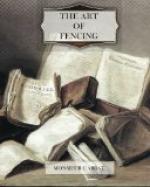4. The same Time, depends on three Things: First, that both having a Design to push, you both push by chance at once, without expecting it from each other: Secondly: That full of the Design to take the Time, and not knowing it, you push upon the Enemy’s Thrust, without foreseeing how to avoid it; and thirdly, when an Inferior or desperate Man, unable to defend himself, had rather run on your Thrust in endeavouring to hit you, than strive in vain to avoid it. These are not only the Occasions of the same Time, but also of the Coups Fourres.
It is to be observed, that Time, and the same Time, differ only in their Figure, and not in their Occasion, as Monsieur De la Touche says, for to take the Time upon a Thrust, you must go off upon the Lunge, as if it were on the same Time, except that the Figure of the Body shuns the Thrust, which in that of the same Time it does not do.
5. False Time, is a Motion made by the Enemy to draw you on, in order to take a Time upon your’s; therefore he that would take the Time, shou’d distinguish whether the Motion made, is to disorder him, and take the Advantage of his Parade, or to make him thrust, and take the Advantage of his Lunge; In Case of the first, it would be a Fault not to push; and in Case of the other, it would be amiss to push. Some Masters call the false Time, Half Time, which is wrong, every Motion being a Time, and as it is impossible to make a Half Motion, so ’tis impossible to make a Half Time.
The Difference of Time between the dexterous and awkard is, that the dexterous present and take the Time, and the others, give and lose it.
CHAP. XXVII.
Of Swiftness.
Swiftness is the Shortness of Time between the Beginning and End of a Motion: It proceeds from a regular and frequent Exercise, joined with a good Disposition; that is to say, Vigour and Suppleness, which form Agility.
A great Swiftness cannot be acquired without long Practice and a good Disposition, the one not being sufficient, without the other, to give it: For the best natural Parts, without Practice, will be of very little Service to those who have the best Disposition; and the most regular Practice without the Assistance of Nature, will never make a Man perfectly Swift.




